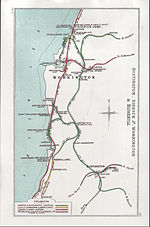Harrington Junction
1973 disestablishments in EnglandRail junctions in EnglandRail transport in CumbriaUse British English from January 2018

Harrington Junction was a railway junction in Harrington, Cumbria, England. It joined three branches to the Cleator and Workington Junction Railway's (CWJR) main line from Workington Central to Moor Row via Cleator Moor West. No station ever existed at the junction, High Harrington was the nearest, 48 chains (0.97 km) to the south. Former employees described the junction as the CWJR's "nerve centre".
Excerpt from the Wikipedia article Harrington Junction (License: CC BY-SA 3.0, Authors, Images).Harrington Junction
Moorclose Road,
Geographical coordinates (GPS) Address Nearby Places Show on map
Geographical coordinates (GPS)
| Latitude | Longitude |
|---|---|
| N 54.623055555556 ° | E -3.5491666666667 ° |
Address
Harrington Junction
Moorclose Road
CA14 5BF , Salterbeck
England, United Kingdom
Open on Google Maps









